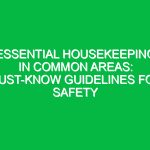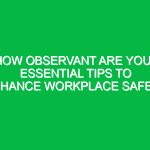“`html
Essential Housekeeping in the Construction Industry: Avoid Critical Risks
Introduction
Good morning team! Today, we’re going to address a crucial topic that affects all of us on the construction site: essential housekeeping practices. Proper housekeeping is more than just keeping things tidy; it’s about ensuring our Safety and the safety of our coworkers. By focusing on these practices, we can avoid critical risks that can lead to accidents and injuries.
Housekeeping in the construction industry is often overlooked, but it plays a vital role in maintaining a safe working environment. A clean site not only helps in preventing accidents but also boosts productivity. Let’s dive into why this topic is important and how each of you can contribute to a safer workplace.
Understanding Essential Housekeeping
Essential housekeeping refers to the systematic approach of maintaining cleanliness and order on construction sites. This includes everything from proper storage of tools and materials to keeping walkways clear and ensuring waste is disposed of correctly. Effective housekeeping practices are essential for minimizing Hazards, improving efficiency, and fostering a culture of safety.
It’s important to understand that good housekeeping can significantly impact our daily operations. When our work area is organized, we can locate tools and materials quickly, reducing the time spent searching for them and minimizing distractions. Many employees may mistakenly believe that housekeeping is a menial task, but it’s actually a key component of our health, safety, and environment (HSE) strategy.
Key Hazards, Risks, and Safety Considerations
Let’s take a closer look at some of the common hazards associated with poor housekeeping:
- Slips, Trips, and Falls: One of the leading causes of injuries on construction sites is slips, trips, and falls, often due to debris, tools left out, or uneven surfaces.
- Inadequate Storage: When materials and tools are not stored properly, they can become hazards. Items falling from heights or being tripped over can lead to serious injuries.
- Fire Hazards: Poorly managed waste and clutter can increase the risk of Fires. Flammable materials should always be stored in designated areas away from ignition sources.
- Health Hazards: Dust, debris, and hazardous materials can affect our health. Proper housekeeping helps to minimize exposure to these risks.
Ignoring these safety protocols can lead to real-world consequences, including severe injuries, project delays, and increased insurance costs. It’s essential to prioritize housekeeping to mitigate these risks.
Best Practices, Procedures, & Actionable Advice
Now that we understand the risks involved, let’s discuss some Best Practices for effective housekeeping:
1. Keep Work Areas Organized
Each team member should take responsibility for keeping their work area tidy. This includes:
- Storing tools in designated areas when not in use.
- Keeping materials stacked neatly and securely.
- Regularly cleaning work surfaces to remove debris.
2. Clear Walkways and Exits
Ensure that all walkways, exits, and emergency exits are clear of obstacles. This means:
- Regularly checking that materials and tools are not obstructing pathways.
- Ensuring that any spills are promptly cleaned up to prevent slipping.
- Using signage to indicate Hazardous Areas or wet floors.
3. Proper Waste Disposal
Establish a waste disposal plan that includes:
- Designated bins for different types of waste (e.g., hazardous waste, recyclable materials).
- Regularly scheduled waste removal to prevent accumulation.
- Training employees on how to dispose of materials safely.
4. Conduct Regular Inspections
Regular inspections can help identify potential hazards. Implement a routine check that includes:
- Assessing the cleanliness of the site.
- Checking for proper storage and organization of tools and materials.
- Identifying areas that require immediate attention or additional cleaning.
Let’s remember the incident involving a colleague who tripped over a loose cable left on the ground. This could have been avoided with proper housekeeping. By taking these steps, we can create a safer workplace for everyone.
Regulations, Standards, and Compliance
Understanding the regulations and Standards that govern housekeeping in the construction industry is crucial. Key organizations like OSHA (Occupational Safety and Health Administration) provide guidelines that outline the Best Practices for maintaining a safe work environment.
For example, osha’s standards include requirements for:
- Maintaining clean and orderly workplaces.
- Providing adequate waste disposal facilities.
- Ensuring that workspaces are free from unnecessary hazards.
Compliance with these standards not only protects us as employees but also shields the company from potential legal liabilities. It’s everyone’s responsibility to adhere to these regulations and report any unsafe conditions.
Employee Engagement & Discussion
Now that we’ve covered essential housekeeping practices, I’d like to hear from you. What specific safety challenges have you encountered related to housekeeping? Are there any practices you feel could be improved at our site? Your feedback is invaluable, and discussing these issues openly can lead to better safety solutions for all of us.
Conclusion & Key Takeaways
To wrap up, let’s summarize the main points we discussed:
- Essential housekeeping is vital for maintaining a safe construction site.
- Common hazards include slips, trips, falls, and inadequate storage.
- Implementing best practices can significantly reduce risks.
- Compliance with safety regulations is crucial for protecting everyone on site.
Remember, safety starts with each one of us. By actively participating in housekeeping practices, we can create a safer environment for ourselves and our coworkers. Thank you all for your attention and commitment to safety. Let’s make today a safe and productive day!
“`


